|
Washtub Bass:
Objectives: Make an instrument yourself; find effects of changing tension and length of the cord connecting the post and the tub; appreciate low frequency notes; use for rhythm effects.
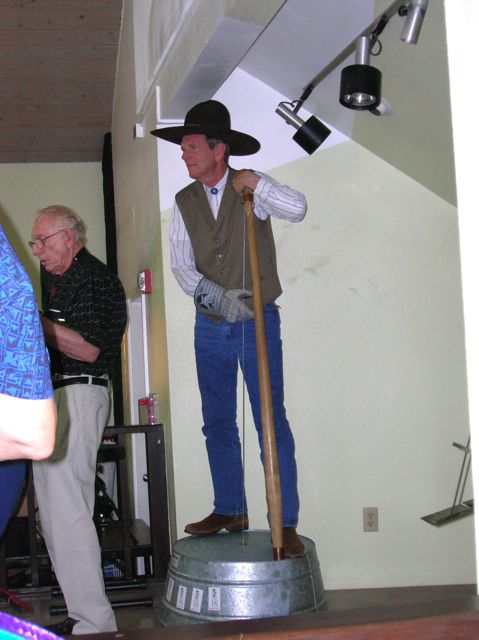
Shown above Washtub Jerry: possibly the world's best washtub bass player.
Plan: A washtub bass has three main components: a large washtub, a handle from a rake or hoe, and a piece of heavy clothesline cord or nylon cord. The bass is assembled by cutting a notch in the bottom end of the rake handle so that it will fit over the rim of the tub when it is placed with the open end on the floor. A hole is drilled through the middle of the bottom of the tub and an eyebolt is placed through the hole and fastened so that the eye is on the bottom of the tub and can be used to attach the cord. The other end of the cord is threaded through a hole drilled through the top end of the rake handle and adjusted so that the cord becomes tight when the rake handle is upright with its lower end notch on the rim of the bottom of the tub. Detailed instructions can be found at jugmusic.com.
The instrument is played by plucking the cord with one hand while the tension of the cord is changed when the other hand pulls the top of the rake handle. Changing the tension gives different notes. Different notes can also be accomplished by shortening the length of the cord by holding the cord against the rake handle. Using heavier cord will result in a lower pitched instrument.
The princibles shown here are basic for all stringed instruments. The instrument can be used as a rhythm instruments if producing the right notes is difficult.
Draw a Keyboard
Objectives: Learn about the notes of the 12-tone scale and about different keys in which music can be played.
The classroom music teacher will have to remember the first experiences which probably involved a piano which has become less popular than formerly. If the students are not familiar with keyboards they will have difficulty understanding the notes of a major scale which are not evenly spaced due to the fact that most steps are a full note but two are half steps. Therefore project one should be for the student to obtain a keyboard instrument and play a scale on the white keys only, starting with middle C.
When the student has done this he or she should be instructed to draw and label the notes on a keyboard. The concept of sharps and flats should be explained. The student should then be shown the lines for the treble clef and how the notes on the score correspond to those on the keyboard. Then the student can be shown how to play "Jingle Bells" or some other simple tune.
Play a Scale on the melodica.
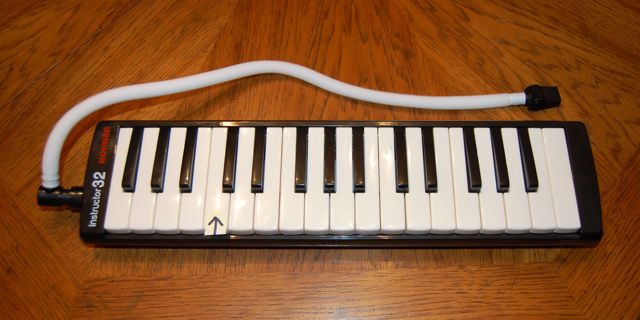
The picture above showas a melodica. This instrument can be purchased for around $50.00. It is played by blowing into the mouthpiece at the end of the white tube while pressing down on the proper keys to play a scale or melody. The arrow is on the note dalled "middle C" when it is played on the piano. The scale in the key of C consists of only the white keys and begins on the note "C" where the arrow is. The names of the notes as they ascend the scale a C D E F G A B C. After the note G come the note A and then B and then C which is one octave higher than middle C. ( The scale has 8 notes, hence octave). If a scale is played beginning with A and ascending up an octave on the white keys only the scale will be in A minor. Notice the difference in sound of a major scale and a minor scale.
The black keys are in groups of two or three. The note to the left of the group of two black keys is C. Notice that there is another C note seven white keys up from the middle C. A scale in the key of C one octave higher can be played staring with this note.
The black keys are there to sound the notes midway between the white keys and are 1/2 step above or below the white keys next to them. The white keys that have no black key between them are also 1/2 step apart. By using the proper black keys, a scale can be played starting on any note, black or white. The frets on fretted instruments such as the banjo and ukulele are placed so that the note played is 1/2 step higher if you play one fret higher.
Play a scale in other keys.
Play a scale starting on F and go up one octave and back down to F. Does this sound like a finished scale? No. Now play the scale using Bb instead of B from F up and back one octave. Does this sound better? Yes. This because the interval between the 3rd and 4th notes must be a half step which requires the use of the black key Bb. The possibilities of the melodica are demonstrated by jazz musician Jon Batiste. Another Jon Batiste clip, and ukulele plus melodica plus vocal clip:
Build a Cigar Box Ukulele
The cigar-box ukulele shown here might appear to be too clunky to sound good--but appearance is wrong: the uke has a great sound and is easy to play. The fact that there is no hole in the uke gives it a clean and clear tone without the low monotone drone note heard on ukuleles that have a soundhole.
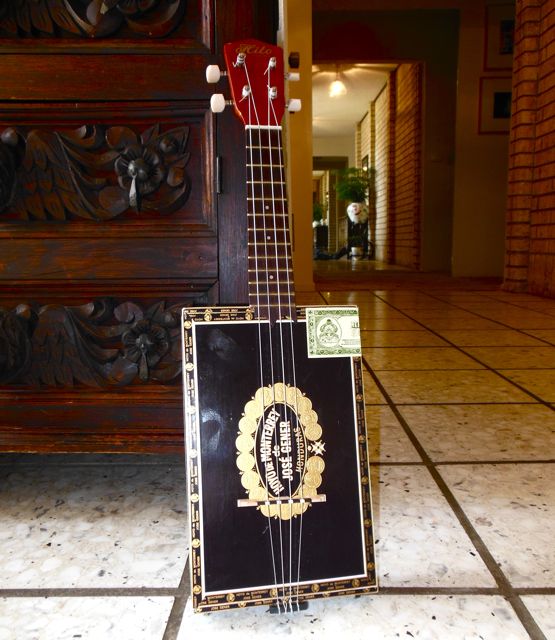
Shown above: High Class Cigar Box Ukulele simple home-made version.
The main parts are shown below. You may have to have the shop class help with cutting the brace and drilling the holes. The dowel can be 3/4 or 1/2 inch diameter; The piece of wood can be 1/2 or 3/4 thick and should be narrow enough to fit down in the box. The dowel should be cut so that it just fits lenghthwise in the box. The neck can be attached with one 2 1/2 inch screw and the tailpiece can be attaced with a small 1/2 or 3/4 inch screw. The bridge is from a tenor banjo. The neck is from a damaged ukulele but if you can't find one you can get one from mainlandukes.com.
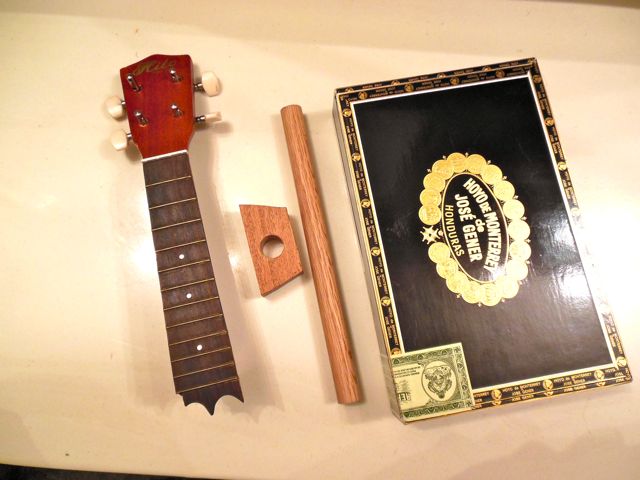
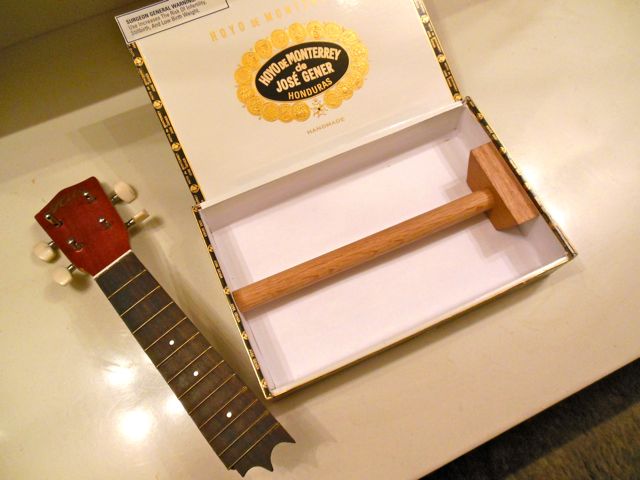
In the picture above the dowel has been glued in the hole in the piece of wood so that the end of the dowel is flush with the side of the piece of wood. The dowel and piece of wood are placed in the cigar box but need not be glued in. The neck is attached at the end where the piece of wood is located with one 21/2 inch size 10 screw.
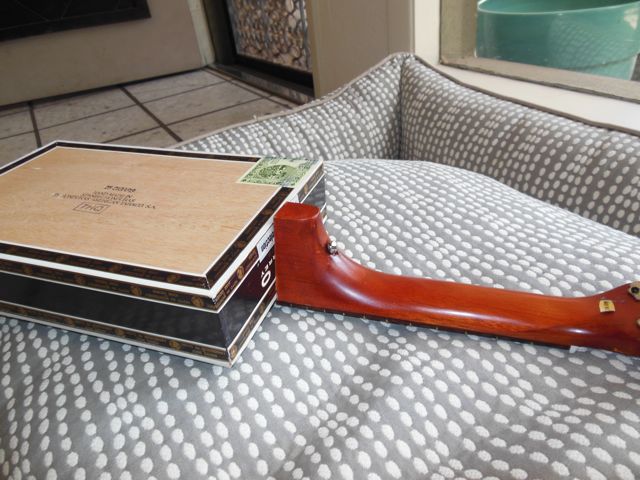
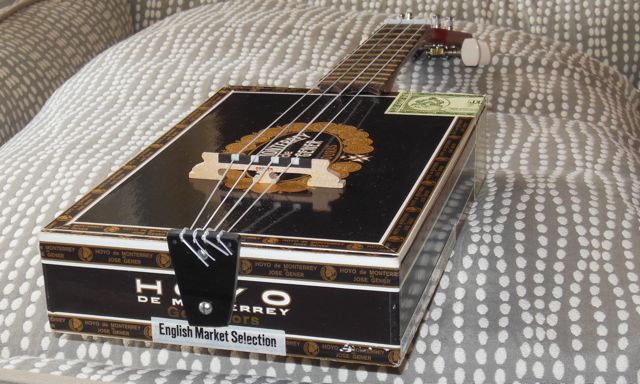
The tailpiece can be made from plastic, wood or metal. The top of the box is held down by the pressure of the strings against the bridge. No gluing is needed. The strings are Aquila Bionylon concert-size ukulele strings. The neck may have to have shims to tilt it back from the cigar box body to adjust the action so that the strings are the proper height above the frets. The bridge is positioned so that the distance from the bridge to the 12th fret is the same as the distance from the 12th fret to the nut (the piece of plastic with notches in it). You can hear me play this ukulele on youtube.com under cheap uke cigar box. I play "Don't Bring Lulu".
|